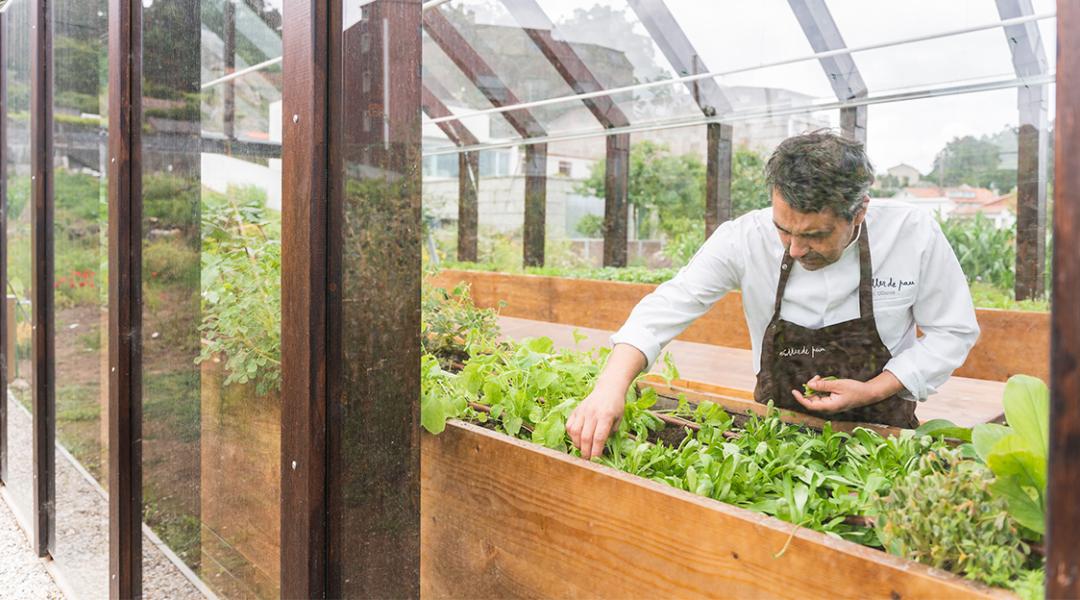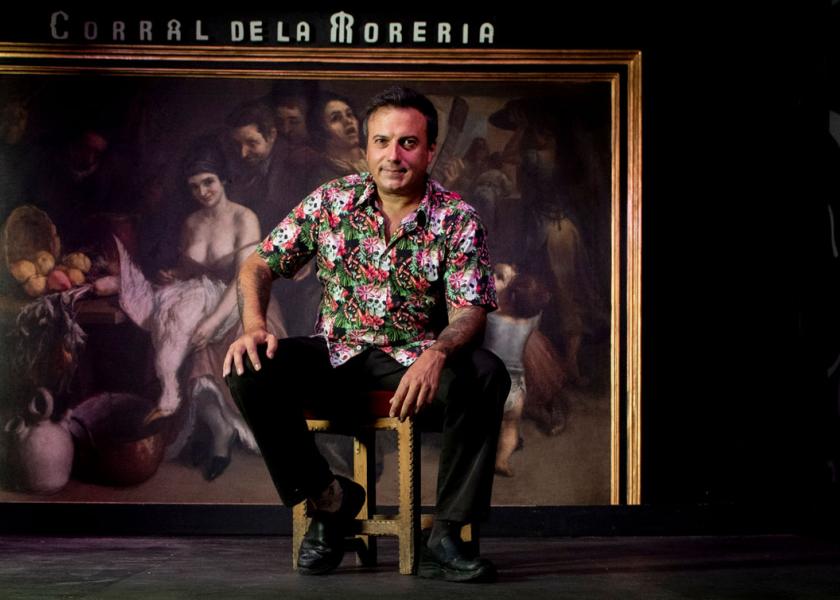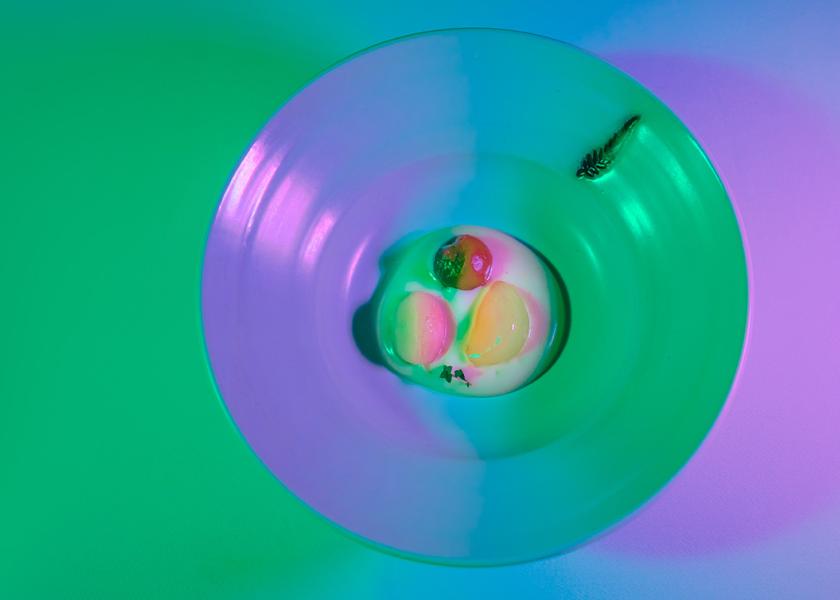The Best Chef Awards
Cutting-edge Spanish cuisine

Innovation, sustainability and lots and lots of passion have placed our country at the forefront of the international gastronomic vanguard. And so it was accredited in The Best Chef Awards 2022, where 16 Spaniards made it into the Top 100 of the "best chefs in the world". To unravel the reasons behind this great moment, we talked to chefs Diego Guerrero, Paco Roncero, Javier Olleros, Jorge Martín and Pep Moreno. Talent that smells of the future and tastes even better. Talent that smells of the future and tastes even better.
Pectins, carbohydrates, phospholipids… The Spanish stove is putting out a new language cemented in technological breakthroughs and being open to experimentation. Products and techniques are adapted and reinvented, within an environment of healthy competition, to improve our gastronomic proposal. The result couldn’t be more encouraging: a total of 16 national chefs have made it into the Top 100 of The Best Chef Awards this year, making Spain the country with the highest representation in the ranking. During the gala, held in Madrid on the 20th of September, Dabiz Muñoz revalidated his first place in the table. He was joined by Joan Roca (El Celler de Can Roca), Andoni Luis Aduriz (Mugaritz) —also awarded The Best Chef Award Science— and Oriol Castro, Mateu Casañas and Eduard Zatruch (Disfrutar) in third, fifth and seventh position respectively.
There is no trick or secret recipe here: Spanish gastronomy has excelled at combining tradition and vanguard, R&D&I and artisan nature with a single objective, elevating the flavour of our dishes to their full potential. And all adapted to current needs: “Squid has natural emulsifying and foaming abilities thanks to the phospholipids it contains. This allows us to make a fritter with an incredible fluffy texture similar to cream or soda… A delicious and surprising dish made with a single product that is suitable for people who are gluten-free. That’s optimum use,” explains Diego Guerrero, chef at DSTAgE with two Michelin stars and 38th in the ranking.
The success of Spanish gastronomy is related to union and ambition. “One of the keys has been that we work hard to be the best and, therefore, make our customers happy. If that involves recognition, even better. But pressure is self-imposed,” confirms Paco Roncero, who also has two Michelin stars and has been betting on technical and creative innovation in different projects within and outside of Spain (Estado Puro, GastroHub and Casino de Madrid).
“Chefs travel more, share more forums and experiences around the world. This enriches gastronomy”
According to Diego Guerrero, this boom seems to come from an internationalisation process of cuisine. “Chefs travel more, share more forums and experiences around the world. This enriches gastronomy. Researching, going to markets, speaking to others, looking for techniques and products, gives you more freedom. Seeing that your point of view is not the only one and that there are different ways of facing life in general expands your mind.
Art and science hand-in-hand
“There is a balance between art and science. We can use artistic and aesthetic language to show what’s inside, but with the exactitude that science gives us to understand what we do.” These are the words of Javier Olleros, chef and owner of Culler de Pau —with two stars, he was also nominated to The Best Chef Awards 2022— based in O Grove (Pontevedra). At his 2,500-m2 organic plantation, he recovers endangered species and researches how to make the most of each vegetable.
“At our vegetable garden we’ve recovered crops like teardrop peas, Galician collard greens, sweet corn, black corn, and a wonderful discovery: Salicornia, the ancestor of sea asparagus that helped us represent an ecosystem.” Regarding his process, Olleros highlights that, through techniques, “we can specify cooking times and, above all, the work we do with fermenting, which helps us to extend the life of products. Therefore, a grain such as corn can turn into a product full of nuances in flavour.”
For Jorge Martín, R&D head chef at Dani García group, restaurants “have become museums where you go to witness and eat art”. In his opinion, “without R&D&I, cuisine wouldn’t have gotten half as far as it currently has,” although we mustn’t forget that the goal is to “cook tasty food well”, and that’s “artistic”. For more than 15 years, Martín works developing new products for the group of this famous chef from Marbella.
“Science, which comes into play even when frying an egg,” according to Guerrero, increasing the chances chefs have to experiment. Also, despite the fact that ingredients are now better known and deconstructed, there are more surprises to be found. This is what happened to Jorge Martín: “We developed a dish for Leña Madrid consisting of chargrilled leek and we realised that, when we let it stand, the leek exuded a crystal-clear liquid with a strong roasted leek flavour, which we use. This test allowed us to go beyond our initial expectations and was incredibly successful,” he explains.
Pep Moreno, chef at Deliranto (one Michelin star, also nominated for Best Chef in the World), leans towards the scientific side without leaving out other considerations. “The basis of all cooking is, undoubtedly, science: bread rising, the texture of a sauce, the perfect emulsion... Furthermore, the experiences suggested by bolder and more modern restaurants include an undeniable artistic component.”
“The basis of all cooking is, undoubtedly, science. There’s also an undeniable artistic component”
Talent, teamwork, and rock ‘n’ roll
But, beyond the increasingly recurring presence of R&D&I, cuisine is still a group effort, involving teamwork. Surrounding oneself with talented people is important. “Feeding off of talents from other disciplines and incorporating them one way or another has had a big impression on me,” explains Roncero. “For me, there are three must-haves: tradition, teamwork, and product,” says Pep Moreno, who wants his guests to have experiences and sensations beyond flavours —his menu has a different theme each season—.
There’s consensus regarding the essential conditions related to innate cooking skills: day-to-day work and values. “Perseverance, discipline, and humility,” notes Martín, while Olleros indicates that “we all join forces and, from there, the goal is to be happy with our work.” Guerrero finishes off: “With good foundations and knowing why you do things, you can face the pressure. Sacrifice, hard work, and willingness to tell a story. Being aware of mistakes and carrying on. That’s your day-to-day, your rock ‘n’ roll.”
Dishes that talk
Cooking processes now include complex techniques, but the goal is still the same: remaining close to the essence, to the purity of the ingredients, to establish direct communication with the dinner guest during the tasting of each dish. “When you leave things bare, your defects show through more, but if it’s been well done, you’ll get there better and faster. It’s a sign of maturity. Our cuisine demands that naturalness, working hard to try to tell the story through simplicity,” explains Diego Guerrero. Inside the walls of a restaurant, the dish acts as the message between the sender and receiver; for it to be expressed with the most eloquence is one of the main challenges of this new culinary language. This communication goes straight to the taste buds and the heart, in that cuisine is “a form of expression to tell and convey strong messages, I’d even say it has the ability to transform,” declares the chef.
“Gastronomy needs to fly and be nourished by other cultures and ways of working, observing their techniques and influences”
And, what about the future? “I’m optimistic about young people because they have a sensibility that we lacked, and I believe it’ll be a force for change. They have a lot of strength to try and build a more inhabitable world with an awareness that comes from the less predatory side of human beings,” predicts Javier Olleros. Because beyond products, flavours, or techniques, in the kitchen there are less tangible, but equally decisive ingredients. Paco Roncero convincingly tells us: “Gastronomy needs to fly and be nourished by other cultures and ways of working, observing their techniques and influences”. Talent, travel, and science go hand-in-hand for the brilliant present —and future— of Spanish gastronomy.










